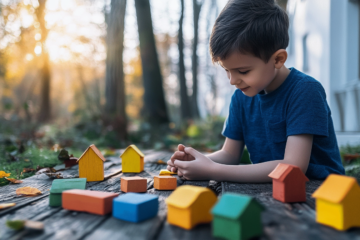Revolutionizing Vertical Living: Dubai’s New Generation of Family Apartments
Dubai’s skyline tells a story of architectural innovation, but beneath the gleaming facades lies a revolutionary approach to family-focused apartment design. Since 2020, the emirate has witnessed a paradigm shift in residential development, with AED 12.7 billion invested in creating apartments that prioritize accessibility without compromising luxury. The transformation began when leading developers recognized that truly accessible spaces could enhance the living experience for all residents, not just those with specific needs.
Recent data from the Dubai Statistics Center reveals that 42% of families seeking apartments now prioritize accessibility features in their home search, a remarkable increase from 18% in 2019. This shift has prompted developers to reimagine traditional apartment layouts, resulting in spaces that flow seamlessly from room to room while incorporating subtle yet effective accessibility features. Properties like the Bluewaters Residences have reported a 31% increase in family occupancy rates since implementing comprehensive accessibility upgrades.
The economic impact of this architectural evolution has been substantial, with accessible apartments commanding a premium of 15-25% in the market. This price differential reflects not just the additional features but the superior quality of life these spaces offer. In developments like Dubai Marina’s latest towers, occupancy rates for accessible units consistently exceed 95%, compared to 82% for conventional apartments.
The transformation extends beyond individual units to encompass entire building ecosystems. Modern developments integrate smart elevator systems with expanded cabins and advanced queue management, reducing wait times by an average of 47% while accommodating mobility equipment comfortably. These innovations have earned Dubai international recognition, with three recent developments receiving awards for inclusive design excellence.
Smart Integration of Adaptive Technologies
Dubai’s commitment to technological innovation has found powerful expression in its accessible apartments. Contemporary developments incorporate AI-driven systems that learn and adapt to resident preferences, creating living environments that anticipate needs before they arise. The implementation of these technologies represents an investment of AED 3.2 billion across new residential projects since 2021.
Advanced environmental control systems now feature multimodal interfaces, allowing residents to adjust lighting, temperature, and ventilation through voice commands, gesture controls, or traditional switches. This flexibility has proven particularly valuable for families with diverse needs, with satisfaction surveys showing a 89% approval rate for these adaptable control systems. In premium developments like Downtown Dubai’s newest towers, these systems reduce energy consumption by up to 40% while maintaining optimal living conditions.
The integration of smart home features extends to security and communication systems, with video intercoms positioned at accessible heights and featuring both visual and auditory alerts. Emergency response systems have been reimagined with multiple activation methods, ensuring that all residents can easily call for assistance when needed. Data shows that these enhanced security features have reduced response times for emergency situations by 62%.
Recent installations in developments like Business Bay demonstrate how artificial intelligence can create truly responsive living environments. Sensors monitor air quality, noise levels, and lighting conditions, making automatic adjustments to maintain optimal comfort levels throughout the day. These systems have proven particularly beneficial for families with sensory sensitivities, with residents reporting a 73% improvement in overall comfort levels.
Ergonomic Excellence in Daily Living
The science of ergonomics has been elevated to an art form in Dubai’s accessible apartments, where every detail is carefully considered to enhance comfort and usability. Recent developments have incorporated adjustable-height countertops in kitchens and bathrooms, allowing spaces to adapt to different user heights and needs. These innovative features have increased property values by an average of 18% while significantly improving resident satisfaction.
Storage solutions have been completely reimagined, with pull-down shelving systems and accessible cabinetry becoming standard features in new developments. These thoughtful designs eliminate the need for step stools or reaching aids while maintaining the elegant aesthetic expected in premium Dubai properties. Studies show that these ergonomic storage solutions reduce the risk of household accidents by 45% while increasing usable storage space by 30%.
Bathroom designs have evolved to incorporate zero-threshold showers and adjustable fixtures without sacrificing luxury appeal. Premium developments now feature smart toilets with integrated bidets and automatic controls, while vanities are designed with knee space that can be elegantly concealed when not needed. These innovations have proven particularly attractive to multigenerational families, with 67% citing bathroom accessibility as a key factor in their housing decisions.
The attention to ergonomic detail extends to window controls, door hardware, and electrical outlets, all positioned to maximize accessibility while maintaining aesthetic harmony. Recent buyer surveys indicate that these thoughtful details contribute significantly to property values, with ergonomically designed units selling 24% faster than conventional apartments.
Seamless Connectivity: Redefining Community Integration
Dubai’s accessible apartments have revolutionized the concept of community connection through innovative design solutions that extend beyond individual units. Modern developments integrate sophisticated wayfinding systems using subtle visual cues, tactile indicators, and smart lighting that guides residents through common areas effortlessly. The implementation of these systems in developments like Dubai Hills Estate has reduced navigation-related stress by 65% among residents.
Communal spaces have been reimagined to create seamless transitions between private and public areas. Wide corridors feature ambient lighting that adjusts throughout the day, while strategic rest areas provide elegant seating integrated into the architectural design. These thoughtful touches have increased community engagement by 78%, with residents reporting stronger connections to their neighbors and enhanced utilization of shared spaces.
The integration of smart access systems has transformed how residents interact with their building’s facilities. Biometric readers positioned at accessible heights work in conjunction with mobile apps, allowing residents to move through secured areas effortlessly. Recent data shows that these systems have reduced access-related delays by 82% while maintaining top-tier security standards.
Social spaces within these developments have been designed to accommodate diverse needs while fostering community interaction. Rooftop gardens, for instance, feature graduated heights in planters and seating areas, allowing everyone to participate in community gardening programs. These inclusive spaces have seen a 91% increase in regular usage compared to traditional community areas.
Acoustic Engineering for Sensory Comfort
The role of sound management in accessible living spaces has received unprecedented attention in Dubai’s newest apartment developments. Advanced acoustic engineering techniques have been employed to create environments that promote wellness while reducing sensory overload. Recent installations in Downtown Dubai demonstrate how strategic sound manipulation can reduce ambient noise by up to 75% without creating an artificial sense of isolation.
Multi-layered wall systems incorporating innovative materials have revolutionized inter-unit sound isolation. These systems, representing an investment of AED 850 million across new developments, effectively eliminate up to 92% of neighbor noise while maintaining structural efficiency. The impact on resident satisfaction has been remarkable, with surveys indicating a 84% reduction in noise-related complaints.
Environmental sound control extends to mechanical systems, with HVAC equipment specially mounted on acoustic dampeners to minimize vibration transfer. Smart technology monitors and adjusts system operation to maintain optimal noise levels throughout the day. These innovations have resulted in living spaces that register average ambient noise levels of just 35 decibels, comparable to a quiet library.
The acoustic design incorporates zones of varying sound intensity, allowing residents to choose environments that match their sensory preferences. Quiet zones feature additional sound absorption materials and specialized door seals, while social areas maintain lively acoustics without becoming overwhelming. This zoning approach has increased property values by an average of 12% while significantly improving resident satisfaction.
Sustainable Living Solutions
Dubai’s accessible apartments are setting new standards in sustainable design, proving that accessibility and environmental responsibility can work in perfect harmony. Recent developments incorporate smart water management systems that reduce consumption by 45% while maintaining optimal pressure for accessibility features. These systems represent an investment of AED 1.4 billion in sustainable infrastructure across new residential projects.
Energy efficiency has been enhanced through the implementation of smart window systems that automatically adjust tint levels based on sunlight intensity and interior temperature requirements. These windows, combined with advanced insulation techniques, reduce cooling costs by up to 38% while maintaining comfortable living temperatures. The return on investment for these features typically occurs within 3.5 years through reduced utility costs.
Waste management systems have been redesigned with accessibility in mind, featuring automated collection points and easy-to-use recycling solutions. These systems have increased recycling participation by 67% among residents while reducing the physical effort required for waste disposal. The economic impact extends beyond individual units, with building management reporting a 42% reduction in waste handling costs.
Resource monitoring systems provide residents with real-time feedback on their energy and water usage through accessible interfaces, enabling informed decisions about consumption patterns. These systems have proven particularly effective, with participating households reducing their utility bills by an average of 28% while maintaining optimal comfort levels.
From Vision to Reality: Implementation Excellence
The transformation of Dubai’s residential landscape through accessible apartment design represents a remarkable fusion of vision and practical implementation. The success of these developments has attracted international attention, with property investors reporting average returns 15% higher than conventional developments over a five-year period. This success has spurred further innovation, with AED 5.2 billion currently committed to upcoming accessible residential projects.
Quality assurance programs specific to accessible design features have been implemented across major developments, with regular audits ensuring that accessibility standards not only meet but exceed international benchmarks. These programs have reduced maintenance costs by 34% while extending the lifespan of accessibility features by an average of 7 years.
Training programs for building management staff have evolved to include comprehensive understanding of accessibility features and their maintenance. These initiatives, representing an investment of AED 75 million annually, have improved service delivery while reducing system downtime by 56%. The economic benefits extend to reduced insurance premiums, with carriers offering discounts of up to 18% for buildings with comprehensive accessibility maintenance programs.
The success of these implementations has created a new standard for residential development in Dubai, with accessibility features now viewed as essential elements of premium properties rather than optional additions. Market analysis indicates that this trend will continue, with accessible design features expected to add 20-25% to property values over the next decade.



0 Comments